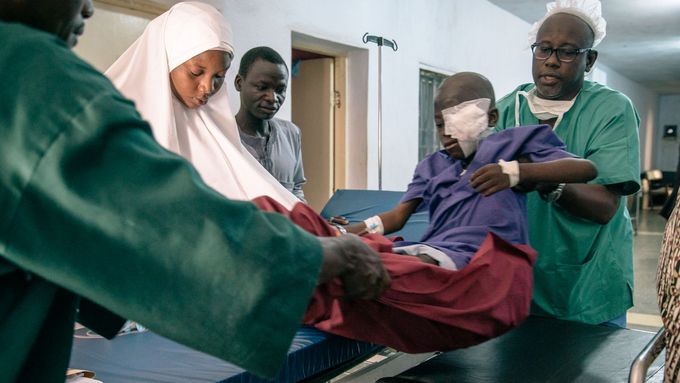Increasing Awareness of Noma – A Severe but Treatable Disease
16.03.2022
There is very limited data on the incidence and prevalence of noma, which hinders better management and treatment of this devastating disease that mainly affects young and malnourished children in very poor communities. With a rigorous systematic literature review on the distribution of noma, Swiss TPH researchers contribute to a better understanding of the epidemiology of the disease and lay the groundwork for systematic control interventions.

A 9-year-old noma survivor from Kano State, right after his second stage surgery at the Noma Hospital in Sokoto. (Photo: Claire Jeantet - Fabrice Caterini / Inediz)
Noma (cancrum oris) is a severe disease originating in the mouth and destroying the face. It predominantly affects children aged 2 to 6 years living in extreme poverty in Africa, Asia and Latin America. The World Health Organisation (WHO) once estimated that 140,000 children are affected yearly by noma, with a prevalence of 770,000 survivors worldwide. The disease leads to the decay of the skin, muscles and bones in the face. Survivors face stigma due to severe facial disfigurement and lifelong hardship as a result of functional disabilities. According to WHO, untreated noma has an extremely high mortality rate, estimated at 90%. Early detection is rare due to a lack of awareness of the disease among both caregivers and health workers. However, noma is treatable at peripheral health system level with antibiotics if detected and treated early.
Swiss TPH researchers conducted a literature review to better understand the epidemiology of the disease that was published yesterday in the peer-reviewed journal The Lancet Infectious Diseases. Key findings from the review indicated that the high focality of data in the scientific literature from West Africa and the varied terms of the disease and different level of awareness of it give a misrepresentation of the global distribution of noma, and that the disease is endemic in several countries traditionally considered noma-free.
With Awareness Comes Recognition
With the lack of data on noma as confirmed by the review, it is currently impossible to calculate global burden estimates. Therefore, a key recommendation of the authors is that the epistemology and nosology of noma need to be systematically defined across actors. “Existing programmes for the control of neglected tropical diseases (NTDs) and poverty reduction should include noma to achieve greater awareness and recognition of the disease through surveillance, prevention and treatment”, said Anaïs Galli, Swiss TPH PhD Student and first author of this publication.
Improved surveillance and systematic reporting are needed to achieve a more inclusive and accurate representation of global noma prevalence and distribution. “Cross-sectional studies should be conducted also in countries beyond West Africa, which are presently absent from the WHO official maps but where conditions for the occurrence of noma are present, namely chronic malnutrition and a near-absence of basic health care. Control and intervention efforts should focus at communal level and primary healthcare facilities, incorporating surveillance and reporting systems to allow active case detection and qualitative data collection”, she added. Other recommendations include education to instil better awareness of noma in high-risk communities including among traditional healers to support early detection and intervention. Improved nutrition is key for disease elimination in the long-term.
First Step to Eradication
The aim of this study was to generate a key resource for WHO to close the evidence gap and consider the inclusion of noma in the WHO list of Neglected Tropical Diseases (NTD) by 2023. “This study is highly relevant in the field of NTDs and the inclusion of noma would elevate the global awareness of noma and stimulate better funding opportunities for research, interventions and support for noma survivors”, said Peter Steinmann, epidemiologist and public health specialist at Swiss TPH and last author of the publication.
“The WHO recognition of noma as a global disease priority will help to generate academic and social impact at local, national as well as international level. The ultimate goal of the inclusion of noma in the WHO NTD list is the elimination of noma and the associated human rights violations among noma survivors due to social rejection, stigmatisation and discrimination”, he added.
Stay connected
Subscribe to our newsletter and get all the latest research news, project updates, course and event listings from Swiss TPH.
